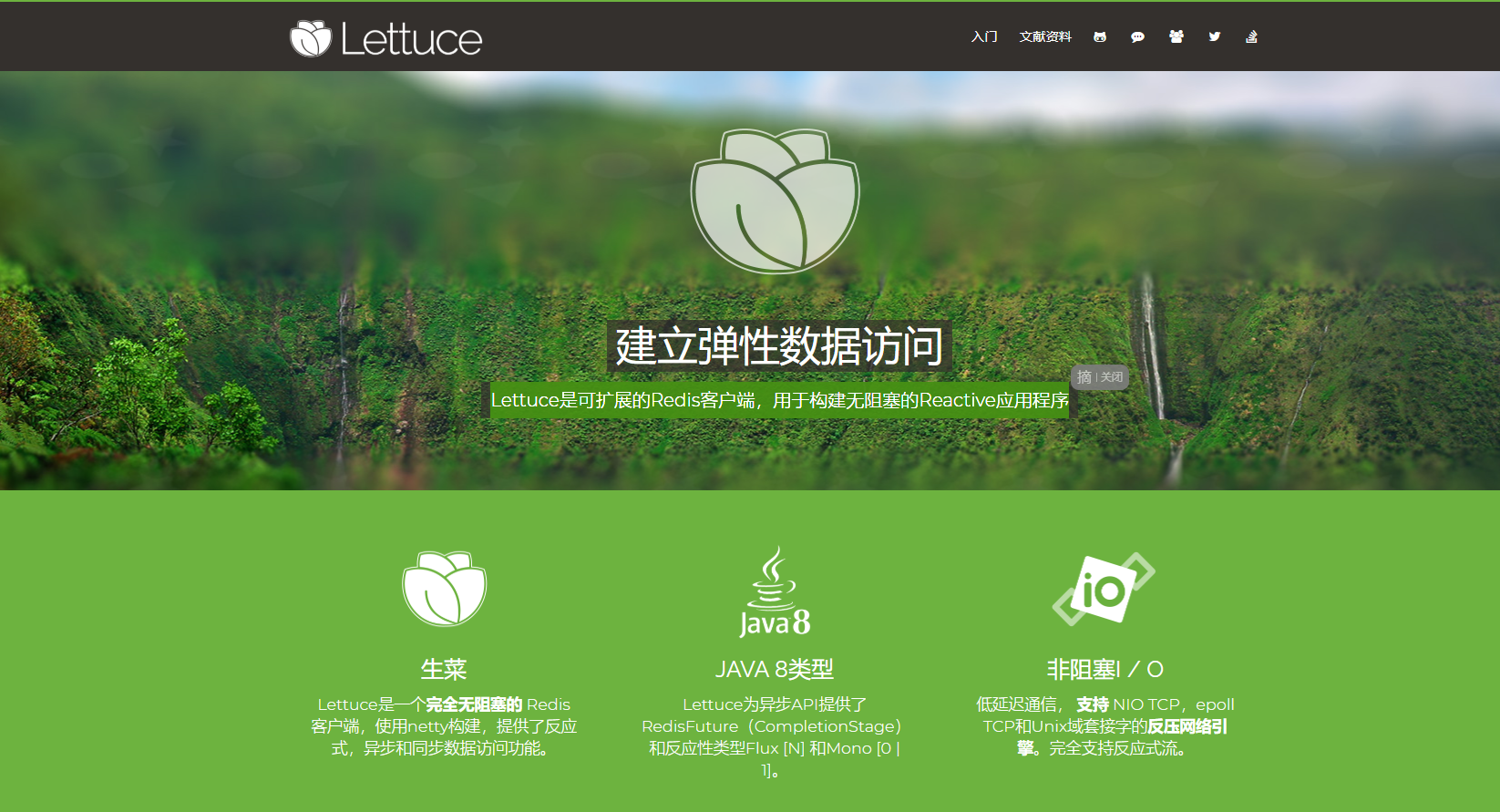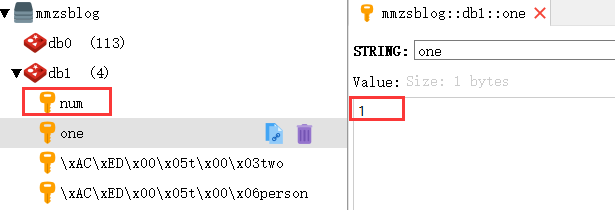我们都知道,把首页数据放到Redis里,能够加快首页数据的访问速度。但是我们要如何准确又快速的将 Redis 整合到自己的 SpringBoot2.x 项目中呢?今天阿淼就带大家爬一爬其中的门门道道。
序、Redis 介绍
Redis 使用了浪费流量的文本协议,但因为它数据存储在内存中的,相对而言,依然可以取得极高的访问性能。并且 Redis 是线程安全的。
RESP 就是 Redis 序列化协议的简称。它是一种直观的文本协议,优势在于实现异常简单,解析性能极好。
Redis 协议里面虽然有大量冗余的回车换行符,但是这不影响它成为技术领域非常受欢迎的一个文本协议。在技术领域,性能并不总是一切,还有简单性、易理解性和易实现性,这些都需要进行适当权衡。
一、Redis 基础数据结构
1、字符串:(缓存)
- key:value
value 可以是对象转换成的 JSON 字符串,也可以是对象序列化后的二进制字符串
2、列表:(异步队列)
类似linkedlist
- 右边进左边出:队列
- 右边进右边出:栈
3、字典(哈希)
类似hashmap:数组+链表
不过rehash是渐进式hash策略
4、集合:(去重)
- 无序 set: 类似hashset
- 有序 zset:类似SortedSet和HashMap的结合体,内部是现实现是跳跃列表
二、Lettuce
随着 Spring Boot2.x 的到来,支持的组件越来越丰富,也越来越成熟,其中对 Redis 的支持不仅仅是丰富了它的API,更是替换掉底层 Jedis 的依赖,取而代之换成了 Lettuce。
虽然 Lettuce 和 Jedis 的都是连接 Redis Server 的客户端程序,但是 Jedis 在实现上是直连 redis server,多线程环境下非线程安全,除非使用连接池,为每个Jedis实例增加物理连接。而 Lettuce 基于 Netty 的连接实例(StatefulRedisConnection),可以在多个线程间并发访问,且线程安全,满足多线程环境下的并发访问,同时它是可伸缩的设计,一个连接实例不够的情况也可以按需增加连接实例。
Lettuce是可扩展的Redis客户端,用于构建无阻塞的Reactive应用程序.
Luttuce官网:https://lettuce.io/

谷歌翻译后的页面是:

原来这玩意儿叫生菜,你别说,看着图标还真有点像。

三、实操
项目中使用的 SpringBoot2.x 实现,如果之前是 SpringBoot1.x 则需要注意,底层已经由 Jedis 升级成了 Lettuce 。
3.1、引入依赖
除去 SpringBoot 项目需要的 jar 包外,另外还需要引入 redis 相关的依赖:
<dependency>
<groupId>org.springframework.boot</groupId>
<artifactId>spring-boot-starter-data-redis</artifactId>
</dependency>
<dependency>
<groupId>org.apache.commons</groupId>
<artifactId>commons-pool2</artifactId>
</dependency>
3.2、application.yml 配置文件
此处用到的 application.yml 文件,配置如下:
spring:
redis:
# Redis默认情况下有16个分片,这里配置具体使用的分片。默认是索引为0的分片
database: 1
# Redis服务器地址
host: 127.0.0.1
# Redis服务器连接端口
port: 6379
# Redis服务器连接密码(默认为空)
password: mmzsblog
# 连接超时时间(毫秒)
timeout: 2000s
# 配置文件中添加 lettuce.pool 相关配置,则会使用到lettuce连接池
lettuce:
pool:
# 连接池最大阻塞等待时间(使用负值表示没有限制) 默认 -1
max-wait: 60s
# 连接池中的最大空闲连接 默认 8
max-idle: 10
# 连接池中的最小空闲连接 默认 0
min-idle: 10
# 连接池最大连接数(使用负值表示没有限制) 默认 8
max-activ: 8
如果项目是由 SpringBoot1.x 升级到 SpringBoot2.x 的,要沿用 jedis 连接池配置时会用到配置 jedis 相关的属性:
# 配置文件中添加 jedis.pool 相关配置,则会使用到 jedis 连接池
jedis:
pool:
max-active: 10
max-idle: 8
min-idle: 0
max-wait: 60s
并且引用的 jar 包也需要调整:
<dependency>
<groupId>org.springframework.boot</groupId>
<artifactId>spring-boot-starter-data-redis</artifactId>
<exclusions>
<exclusion>
<groupId>io.lettuce</groupId>
<artifactId>lettuce-core</artifactId>
</exclusion>
</exclusions>
</dependency>
<dependency>
<groupId>redis.clients</groupId>
<artifactId>jedis</artifactId>
</dependency>
另外,这里再贴一下 Spring Boot 关于 RedisProperties 的所有配置项
# REDIS RedisProperties
spring.redis.cluster.max-redirects= # Maximum number of redirects to follow when executing commands across the cluster.
spring.redis.cluster.nodes= # Comma-separated list of "host:port" pairs to bootstrap from.
spring.redis.database=0 # Database index used by the connection factory.
spring.redis.url= # Connection URL. Overrides host, port, and password. User is ignored. Example: redis://user:password@example.com:6379
spring.redis.host=localhost # Redis server host.
spring.redis.jedis.pool.max-active=8 # Maximum number of connections that can be allocated by the pool at a given time. Use a negative value for no limit.
spring.redis.jedis.pool.max-idle=8 # Maximum number of "idle" connections in the pool. Use a negative value to indicate an unlimited number of idle connections.
spring.redis.jedis.pool.max-wait=-1ms # Maximum amount of time a connection allocation should block before throwing an exception when the pool is exhausted. Use a negative value to block indefinitely.
spring.redis.jedis.pool.min-idle=0 # Target for the minimum number of idle connections to maintain in the pool. This setting only has an effect if it is positive.
spring.redis.lettuce.pool.max-active=8 # Maximum number of connections that can be allocated by the pool at a given time. Use a negative value for no limit.
spring.redis.lettuce.pool.max-idle=8 # Maximum number of "idle" connections in the pool. Use a negative value to indicate an unlimited number of idle connections.
spring.redis.lettuce.pool.max-wait=-1ms # Maximum amount of time a connection allocation should block before throwing an exception when the pool is exhausted. Use a negative value to block indefinitely.
spring.redis.lettuce.pool.min-idle=0 # Target for the minimum number of idle connections to maintain in the pool. This setting only has an effect if it is positive.
spring.redis.lettuce.shutdown-timeout=100ms # Shutdown timeout.
spring.redis.password= # Login password of the redis server.
spring.redis.port=6379 # Redis server port.
spring.redis.sentinel.master= # Name of the Redis server.
spring.redis.sentinel.nodes= # Comma-separated list of "host:port" pairs.
spring.redis.ssl=false # Whether to enable SSL support.
spring.redis.timeout= # Connection timeout.
3.3、自定义一个 RedisTemplate
这个看你自己,不自定义也不影响使用,只是说可能不那么顺手,所以阿淼习惯自定义一个。因为 Spring Boot 在 RedisAutoConfiguration 中默认配置了 RedisTemplate<Object, Object>、StringRedisTemplate两个模板类,然而RedisTemplate<Object, Object>并未指定key、value的序列化器。
@Configuration
public class RestTemplateConfig {
@Bean
public RedisTemplate<String, Serializable> redisCacheTemplate(LettuceConnectionFactory redisConnectionFactory) {
RedisTemplate<String, Serializable> template = new RedisTemplate<>();
template.setKeySerializer(new StringRedisSerializer());
template.setValueSerializer(new GenericJackson2JsonRedisSerializer());
template.setConnectionFactory(redisConnectionFactory);
return template;
}
}
3.4、Person 实体类
声明一个 Person 实体类:
/**
* @author :created by mmzsblog
* @date :created at 2020/06/23 16:41
*/
@Data
@NoArgsConstructor
@AllArgsConstructor
public class Person implements Serializable {
private static final long serialVersionUID = -8183942491930372236L;
private Long userId;
private String username;
private String password;
}
3.5、测试
通过编写一个 UserController 来进行测试:
@RestController
public class UserController {
@Resource
private RedisTemplate redisTemplate;
@Resource
private StringRedisTemplate stringRedisTemplate;
@GetMapping("/set")
public String set() {
stringRedisTemplate.opsForValue().set("one", "1");
// redisTemplate 保存的是字节序列,因为 RestTemplateConfig 自定义的时候指定了 key 和 value 的序列化器。
redisTemplate.opsForValue().set("two", "2");
redisTemplate.opsForValue().set("person", new Person(1L, "luffy", "123456789"));
// 测试线程安全
ExecutorService executorService = Executors.newFixedThreadPool(1000);
IntStream.range(0, 1000).forEach(i -> {
executorService.execute(() -> stringRedisTemplate.opsForValue().increment("num", 1));
});
return "Ok!";
}
@GetMapping("/get")
public String get() {
String one = stringRedisTemplate.opsForValue().get("one");
if ("1".equals(one)) {
System.out.println("key: one" + " || value: " + one);
}
Object two = redisTemplate.opsForValue().get("two");
if ("2".equals(two.toString())) {
System.out.println("key: two" + " || value: " + two);
}
Person user = (Person) redisTemplate.opsForValue().get("person");
if ("luffy".equals(user.getUsername())) {
System.out.println("key: person" + " || value: " + user);
}
return "Ok!";
}
}
用RedisDesktopManager工具查看,数据如下:
用 StringRedisTemplate 设置的键值是String类型的:

用 RedisTemplate 设置的键值是二进制的字节流形式存储的,从截图中的 [Binary] 标识符也能看出:

自定义的 RedisTemplate 和 StringRedisTemplate 并不会有什么冲突,想用 String 存储还是二进制的字节流形式存储完全取决于你自己。
代码地址:https://www.mmzsblog.cn/articles/2020/06/24/1592963113998.html